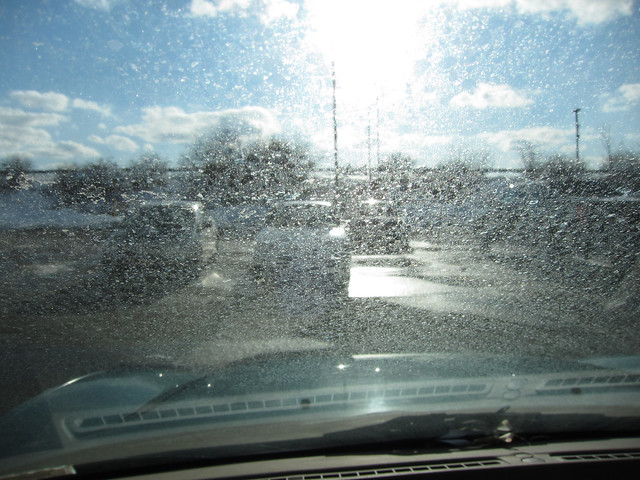Mar 04 2014
Salt Brine Spray For Roads A Hazard

Major Update: Did more researching to confirm the health concern I have, and discovered this [pdf]:
This material is water with 26% dissolved salt. …Airborne mists are corrosive …Contact with material may cause irritation to the eyes and skin. Flush immediately out of eyes and/or off of skin.Prolonged and/or repeated skin contact with this material may cause irritation and dermatitis.Inhalation of salt mists may be irritating to the nose, throat and lungs. Ensure adequate ventilation is available
It has been tough this winter, with all the cold temps and snow. But what has been even worse is the new process for salting the roads. It is a complete disaster, both from a driver safety perspective and from a health perspective.
To understand why driving on the roads has become such a hazard, you have to realize governments have moved from the traditional salt crystal method to a salt brine spray with additives to make it stick like hell to the road – and your windshield:
The traditional road de-icer is road salt, which is fairly inexpensive. However, a significant amount of salt must be distributed onto the road in order to be effective. Whether applied as solid crystals or as a brine solution, salt is ineffective at melting ice below about -10F or -23C.
Some municipalities prefer to spray a brine solution prior to a predicted snowfall. This helps prevent the initial accumulation of ice or snow.
This salt brine mixture was probably OK. It has been in use since around 2009. But like any salt, it will be washed away with the melting snow and ice. Which is how is should be. If the salt can wash away, it won’t remain to be a driving and health hazard. But someone got a bright idea and ran square into the law of unintended consequences:
Although the mix of sugar beet juice with salt brine costs far more than pure brine, it can be cost effective simply due to the greater stickiness of the combined fluid. It does not require as many applications during the course of a winter.
A splash of beet juice, a dollop of molasses, a squeeze of cheese brine. In the coldest weather, the recipe for safer roads often goes beyond the usual sprinkling of salt.
Across the nation’s snow belt, transportation officials are in the market for cheap and environmentally friendly ways to make rock salt work better by keeping it on the roads longer and melting ice at lower temperatures.
…
In Milwaukee, road crews are experimenting with plentiful cheese brine, a leftover from cheese making. New York and Pennsylvania are among states trying sugar beet juice, while molasses and potato juice are flavoring roads elsewhere.
While on the surface this sounds grand, the fact is the very ‘stickiness’ that saves money makes driving and breathing dangerous.
It begins with tire spray:
Car and truck tires (especially truck tires) pretty much atomize the water on the road and throw it up in the air as a mist. And when a road has been treated with the “sticky” variety of salt brine it comes down on your windshield and sticks – in some areas literally like molasses. I attempted to drive to work today, and was unable to go very far because my windshield required CONSTANT cleaning. My washer reservoir was full (I now drive with extra bottles in the car), but I would not have made it the 20 miles I need to go without pulling over and refilling. Strangely, it was not wet enough on the road to allow me to slipstream behind someone and use their tire spray to save on washer fluid. It was too dry on the road – and too sunny.
Every snow, when the sun is out, has 100’s of people pulled over while 100’s more drive by with their windshields coated with sticky salt brine. Now that is a recipe for disaster! It is not making roads safer.
Worse, that sticky, briny mist is carrying salt and other road dirt into the air and into our lungs. Look at what the salt does to the cars, roads, rails and nearby trees! Now just imagine what your lungs look like.
I personally put my car on internally recycled air when the salt is down. I was having huge breathing issues until I did. Think of how much you are inhaling of atomized sticky salt brine when you drive? And heaven forbid you have asthma or other breathing issues.
This is an engineering disaster. It sounded good on paper, but in practice the sticky salt brine has created dangerous driving conditions with salt-caked windshields, the need for people to pull over on busy roads to fill washer fluid, and a very likely health risk that makes second-hand smoke look quaint.
Hopefully we learn our lessons before too many people get hurt.







Thanks, AJ. I hadn’t even thought of that.
Now I’ll have to check what our local highway department uses for de-icer…
Al,
At least back East your roads are covered with edibles. Out West the idiots are using Magnesium Chloride and have been for years. The salt is a terrible corrosive substance to autos and trucks. Google articles about its hazards.
Dan Kurt